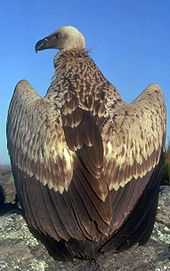Cape vulture
| Cape vulture | |
|---|---|
 | |
| At St Augustine Alligator Farm, St. Augustine, USA | |
| Conservation status | |
| Scientific classification | |
| Kingdom: | Animalia |
| Phylum: | Chordata |
| Class: | Aves |
| Order: | Accipitriformes |
| Family: | Accipitridae |
| Genus: | Gyps |
| Species: | G. coprotheres |
| Binomial name | |
| Gyps coprotheres (Forster, 1798) | |
| Synonyms | |
| |
The Cape griffon or Cape vulture (Gyps coprotheres), also known as Kolbe's vulture, is an Old World vulture in the family Accipitridae, which also includes eagles, kites, buzzards and hawks. It is endemic to southern Africa, and is found mainly in South Africa, Lesotho, Botswana and in some parts of northern Namibia. It nests on cliffs and lays one egg per year.


This large vulture is dark brown except for the pale wing coverts. The adult is paler than the juvenile, and its underwing coverts can appear almost white at a distance. The average length is about 96–115 cm (38–45 in) with a wingspan of 2.26–2.6 m (7.4–8.5 ft) and a body weight of 7–11 kg (15–24 lb).[2][3] They are on average the largest raptor in Africa, although they are subservient to the powerful lappet-faced vulture. After the Himalayan griffon vulture and the cinereous vulture the Cape vulture is the third largest Old World vulture. The two prominent bare skin patches at the base of the neck, also found in the white-backed vulture, are thought to be temperature sensors and used for detecting the presence of thermals.
The species is listed by the IUCN as "Vulnerable", the major problems it faces being poisoning, disturbance at breeding colonies and powerline electrocution. The current population is estimated at 8,000.
References
- ↑ BirdLife International (2013). "Gyps coprotheres". IUCN Red List of Threatened Species. Version 2013.2. International Union for Conservation of Nature. Retrieved 26 November 2013.
- ↑ Raptors of the World by Ferguson-Lees, Christie, Franklin, Mead & Burton. Houghton Mifflin (2001), ISBN 0-618-12762-3
- ↑ vulture facts- Arkive.org (2011).
- Sources
- Sinclair, Ian; Hockey, Phil; Tarboton, Warwick (2002). SASOL Birds of Southern Africa. Cape Town: Struik. ISBN 1-86872-721-1.
External links
| Wikimedia Commons has media related to Gyps coprotheres. |
- BirdLife Species Factsheet.
- Cape vulture - Species text in The Atlas of Southern African Birds.
- Cape Griffon
| ||||||||||||||||||||||||||||||||||||||||||||||||||||||||||||||||||||||||||||||||||||||||||||||||||||||||
